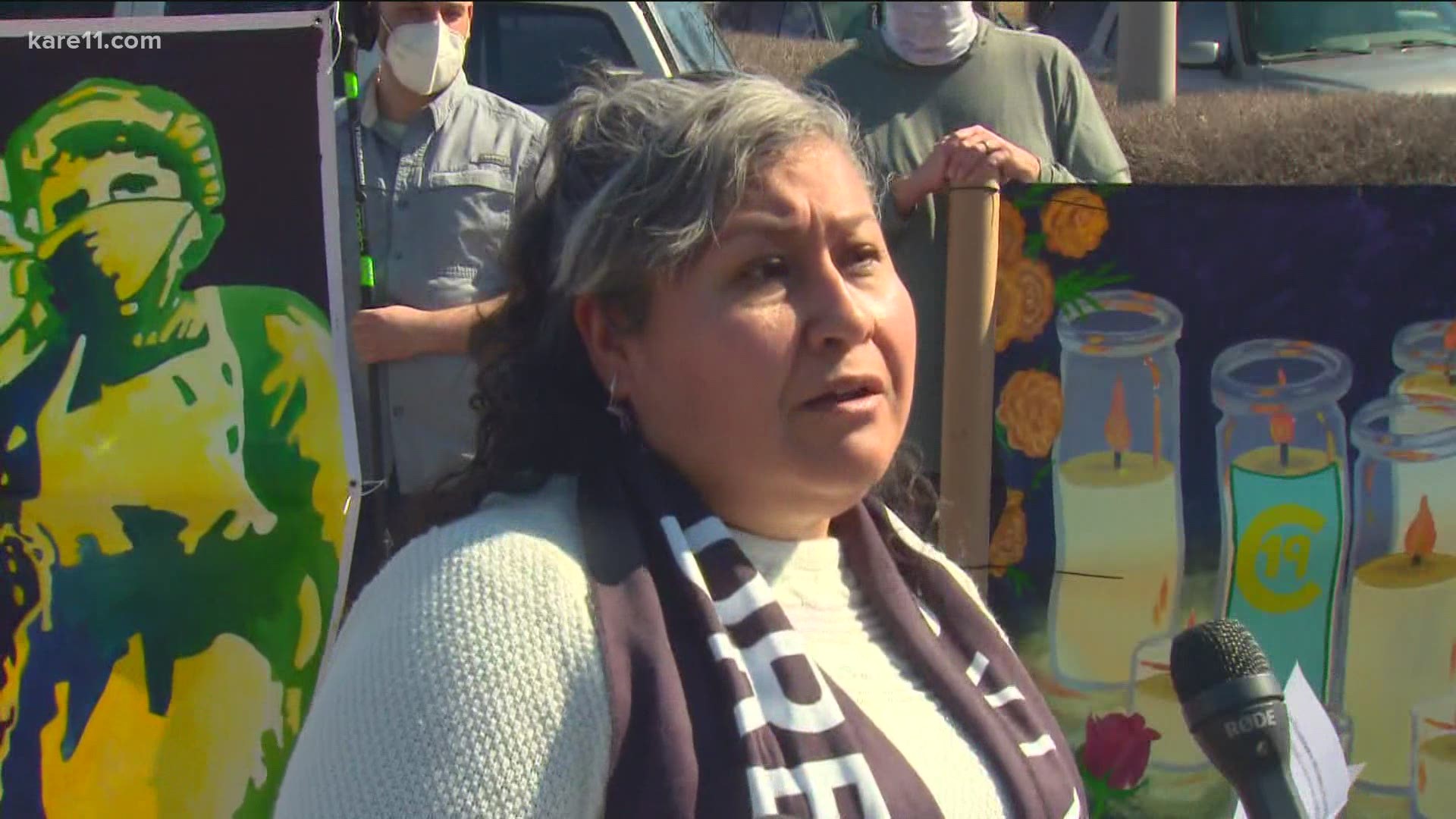ST PAUL, Minn. — Sunday, March 14
- MDH: 22.3% of Minnesota's population has received at least one COVID-19 vaccine dose
- MDH reports 997 new COVID-19 cases, five new deaths
- Minnesota adds CVS, Goodrich Pharmacy to Federal Retail Pharmacy Program network
- Walz rolls back COVID restrictions, increases capacity at bars and restaurants, businesses, large venus
- Vaccinations of Minnesotans age 65-plus "officially" reach 70%
- MDH: New COVID cases top 1,000
- Walz expands COVID vaccinations to 1.8 million Minnesotans starting Wednesday
- Pop-up COVID testing site to open in Carver County following outbreak involving sports, young athletes
11 a.m.
The Minnesota Department of Health (MDH) reported 997 new COVID-19 cases Sunday, along with five new deaths.
MDH's COVID-19 case definition includes both antigen testing and polymerase chain reaction (PCR) testing. Positive PCR test results are considered confirmed cases, while positive antigen test results are considered probable cases.
Sunday's new case total includes 815 confirmed cases and 182 probable cases.
As for vaccinations, MDH says 1,240,140 people have received at least one COVID-19 vaccine dose -- about 22.3% of the state's population. Of that group, 707,776 have received a completed vaccine series. That's about 12.7% of the population.
About 74.9% of Minnesotans who are 65 and older have received at least one dose, MDH says.
The total number of Minnesotans who have tested positive for the virus since the pandemic began is now 497,392, with 26,010 of those as antigen test results.
MDH says five new deaths from the virus were reported. That pushes the total number of fatalities in Minnesota to 6,746.
To date, 26,279 Minnesotans have been hospitalized with the coronavirus since the pandemic started, with 5,428 of them needing care in the ICU.
MDH reports that 482,053 people once diagnosed with the virus have passed the point where they are required to isolate.
2 p.m.
Wisconsin's Department of Health Services (WDHS) reported 462 new cases Saturday, bringing the total number of cases since the pandemic began to 569,364.
Health officials reported 13 new deaths on Saturday bringing total fatalities to 6,538, approximately 1.1% of those who are infected with the virus.
Wisconsin health officials say a total of 26,774 people have been hospitalized from the coronavirus since the start of the pandemic, about 4.7% of the total number of people who have been diagnosed with the virus.
Of the confirmed cases in Wisconsin, 18.8% involve people between the ages of 20 to 29, 15.5% are between 30 and 39, 15.2% are between 50 and 59, and 14.2% are 40 to 49. An estimated 11.6% are between 10 and 19, and 10.9% are between 60 and 69.
As of Saturday, Milwaukee County reported the largest number of confirmed cases with 98,955, along with 1,251 deaths. Dane County has reported 41,262 confirmed cases and 280 deaths, Waukesha County has reported 41,175 confirmed cases and 490 deaths, and Brown County has reported 30,386 cases and 226 deaths.
A more detailed breakdown of cases by county can be found on the DHS website.
11 a.m.
Minnesota is adding CVS Health and Goodrich Pharmacy to its network of pharmacies offering vaccines.
According to a release from the office of Gov. Tim Walz, Minnesota now has five pharmacies with dozens of locations participating in the Federal Retail Pharmacy Program.
Walz said as part of a nationwide vaccine partnership between CVS and Target, three CVS in-store pharmacies at Target stores in Duluth, Rochester and Eden Prairie will receive 3,510 vaccine doses this week. Goodrich Pharmacy will receive 1,170 vaccine doses this week.
According to the release, appointments at the newly-added pharmacies will be available for eligible Minnesotans beginning this weekend.
As for the state's vaccine totals, the Minnesota Department of Health said 1,205,342 people in the state have received at least one vaccine dose -- about 21.7% of the state's population. Of that group, 683,034 have received a completed vaccine series. That's about 12.3% of the population.
In terms of specific high-risk groups, MDH said about 73.7% of Minnesotans who are 65 and older have received at least one dose.
As for other COVID-19 data, MDH said there are 1,191 new COVID-19 cases and four new deaths in the state.
MDH's COVID-19 case definition includes both antigen testing and polymerase chain reaction (PCR) testing. Positive PCR test results are considered confirmed cases, while positive antigen test results are considered probable cases.
Saturday's new case total includes 990 confirmed cases and 201 probable cases.
The total number of Minnesotans who have tested positive for the virus since the pandemic began is now 496,395, with 25,827 of those as antigen test results.
MDH says four new deaths from the virus were reported. That pushes the total number of fatalities in Minnesota to 6,741.
To date, 26,269 Minnesotans have been hospitalized with the coronavirus since the pandemic started, with 5,428 of them needing care in the ICU.
Friday, March 12
Following a recent data pattern, the Minnesota Department of Health (MDH) is reporting new COVID cases above 1,000 and double-digit deaths on Friday.
Health officials recorded 1,107 new cases in the last 24-hours, based on 35,085 tests (31,206 PCR, 3,879 antigen) processed in private and state labs.
MDH told KARE 11 recently that cases and testing volume are low early in the week (Monday and Tuesday) and then steadily climb as the week goes on. In recent weeks cases have regularly been above the 1,000 mark on Thursdays and Fridays.
Minnesota has recorded 495,208 coronavirus cases since the beginning of the pandemic.


Another 13 people have perished from COVID-19, pushing total fatalities to 6,737. Of those deaths 4,237, or 63% of them are associated with assisted living or long-term care facilities.
The state vaccine dashboard says 38,152 doses were administered Wednesday, increasing the number of Minnesotans who have received at least one dose to 1,163,483. That's 20.9% of the state's 5.6 million residents. Of Minnesotans age 65 and older, 72% have been immunized at least once.


As of Wednesday 660,019 people have completed the two-shot COVID series.
Hospitalizations for COVID remain steady, with 240 people currently being treated on an in-patient basis. Of those patients 66 have symptoms serious enough to require treatment in the ICU. Total hospitalizations since the start of the pandemic have climbed to 26,219, with 5,416 of those patients admitted to the ICU.
MDH says 480,133 people who tested positive for the virus at one time no longer need to be isolated.


Young adults ages 20 to 24 are the largest group of cases in the state with 48,987. Three people from that demographic have died. The largest grouping of fatalities is 85 to 89-year-olds, with 1,278 deaths in 6,393 diagnosed cases.
The state's four most populous counties are also the busiest with COVID activity. Hennepin County has recorded 102,700 cases and 1,626 deaths, followed by Ramsey County with 43,724 cases 827 deaths, Dakota County with 37,127 cases and 400 deaths, and Anoka County with 33,898 cases and 402 fatalities.
Cook County in northeastern Minnesota has seen the least COVID activity with just 122 cases.


Thursday, March 11
5 p.m.
The Minnesota Department of Health (MDH) says it has detected the first documented case of a COVID-19 variant in the state known as B.1.351, first discovered in South Africa.
According to MDH, a 40-year-old Twin Cities resident first became ill on Jan. 24.
Although the person did not have any recent travel history at the time, he or she may have been infected by someone who traveled internationally.
The case was first sampled by a commercial lab on Jan. 29 (five days after the individual reportedly became ill), and was not properly identified through genome sequencing techniques until March 10 by the Centers for Disease Control.
This new case comes after the variant was already detected in 21 additional states, including neighboring Wisconsin.
MDH says the variant is thought to be more transmissible, meaning it can spread more easily, though it is unclear if it is more deadly.
2 p.m.
Gov. Tim Walz visited Armstrong High School in Plymouth to speak to the public about his summer learning plan.
According to a news release, Gov. Walz called on the legislature to pass the proposal, which is part of his $150 million COVID-19 Recovery Budget. The plan includes school and community-based learning opportunities, field trips and hands-on learning, mental health support, summer preschool, and college courses for graduating seniors.
“After a year of unprecedented challenges for our students, families, and educators, there is an urgent need for action,” said Gov.Walz in a release. “The learning disruptions caused by COVID-19 have impacted every single student across Minnesota. I call on our Legislature to come together and pass the summer learning plan to help ensure our students aren’t left behind.”
Walz says the proposal will need to be passed by April 15 to allow schools the time to plan for summer learning.
Stephanie Burrage, the interim superintendent of the Robbinsdale Area Schools, said the governor's plan is something that will benefit students and teachers alike.
"It's imperative that we address the mental health needs, the social emotional needs, of our students. This allows us, if we can find out as soon as possible, to start our summer program planning," Burrage told reporters on had in the media center at Armstrong High.
Armstrong's senior class co-president Kaitlyn Doaheuang said many students have told her of the academic and emotional hardships of adjusting to distance learning, so they welcome a chance to get up to speed.
"It is in our best interest to make sure that no student is academically left behind and that preparing each and every student for success in their next chapter is just as important," Kaitlyn remarked.
"It wouldn’t be equitable to assume that every student is academically the same or exposed to the same opportunities."
The Governor's summer school request
Last month, Gov. Walz sent a letter to legislative leaders outlining the plan, which includes:
- Expanding summer 2021 programming by providing students with opportunities to catch up on learning. It will dedicate $57.5 million in federal funds to expand summer programming with small class sizes and transportation for students.
- Expanding summer 2021 preschool for 4- and 5-year-olds by providing $20 million in funding for early learners to attend a star-rated public or private preschool or pre-kindergarten in-person learning program at no cost to them.
- Expanding mental health support in summer 2021 by providing $7 million to expand school-linked mental health services and provide access to well-being support at summer learning programs.
- Providing field trips and hands-on learning in summer 2021 by providing school districts and charter schools with $10 million in supplemental one-time funding for students.
- Accounting for pandemic enrollment loss by maintaining programming that serves all students across the state, including those who are historically underserved. The proposal would provide $25 million in funding to reduce the financial hardship incurred by school districts and charter schools due to a decline in enrollment because of the COVID-19 pandemic.
"It is imperative that we see fast action on summer programming and declining enrollment aid to address our unfinished learning that happened due to the global pandemic," said interim superintendent for Robbinsdale Area Schools Dr. Stephanie Burrage during a press conference Wednesday afternoon. "Like other districts across the state, we have seen an enrollment decline this past year. We know that our students have struggled academically and socially and emotionally."
"Summer programming gives us an opportunity to begin to address the immediate needs of our students," Dr. Burrage added. "It's imperative that we address the mental health needs, the social emotional needs of our students. This allows us – if we can find out as soon as possible – to start our summer program planning."
11 a.m.
Data released by the Minnesota Department of Health (MDH) Thursday officially pushes vaccinations to the milestone set by Gov. Tim Walz as a trigger for expanding COVID-19 immunizations.
More than 25,000 people received doses of vaccine both Monday and Tuesday, pushing the total of Minnesotans age 65 and older who have received at least one shot to 602,866, or 70% of that age demographic. As of Tuesday 1,129,967 people of all ages have received at least one dose, 20.3% of Minnesota's population of 5.6 million.
Of the people who have received at least one dose, 642,701 have completed the two-shot series.

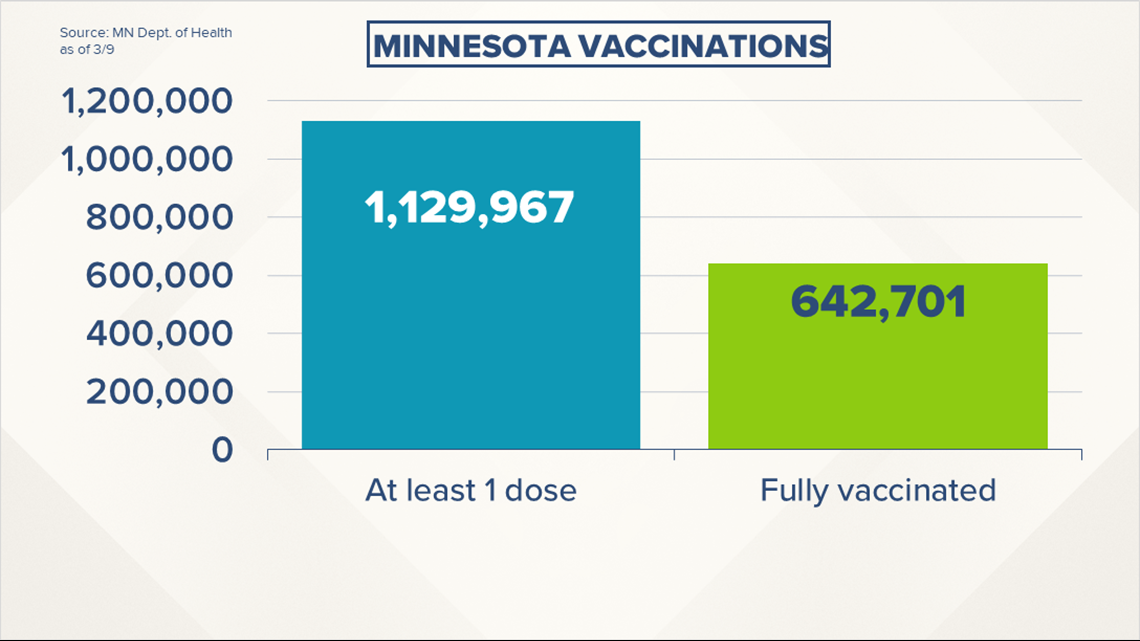
New COVID daily cases have once again climbed over the 1,000 mark with 1,096 reported in the last day. Those cases are based on 37,631 tests (31,784 PCR, 5,847 antigen) processed in private and state labs. Health officials consider a positive PCR test a confirmed COVID case, while a positive antigen test is considered a probable case.

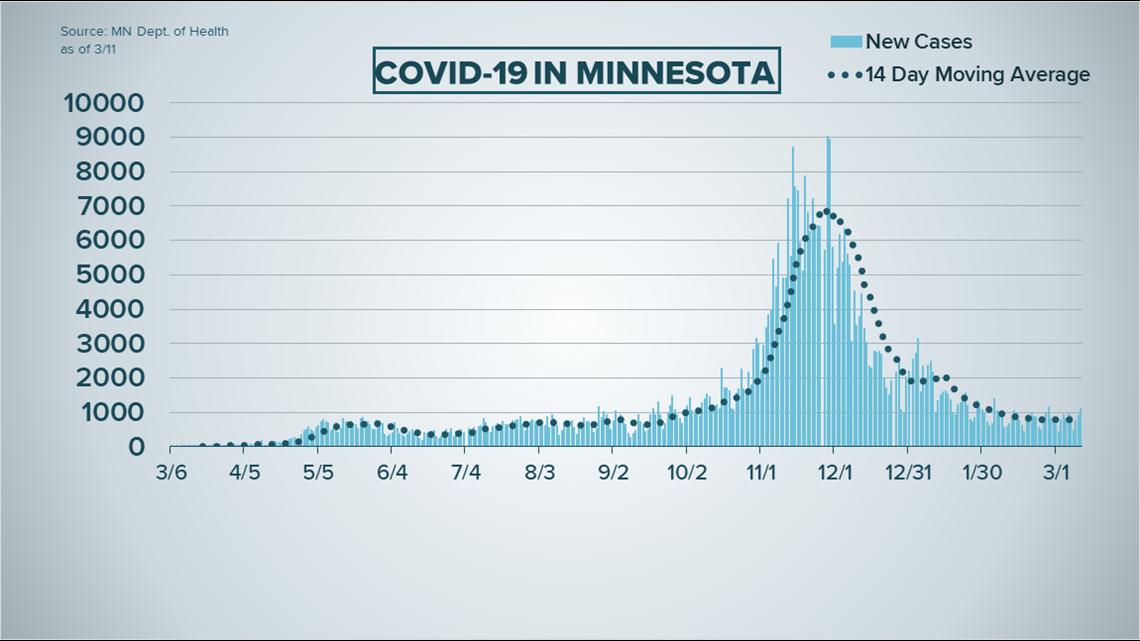
MDH says 19 more people have perished from the virus, bringing coronavirus deaths in the state to 6,724 since the start of the pandemic.
The number of people currently being treated for COVID-19 in hospitals across the state remains steady at 236, with 63 of those patients requiring treatment in the ICU. Bed availability at hospitals in the Twin Cities has dipped, with just 101 non-ICU beds open (2.7%). Total hospitalizations have risen to 26,177, with 5,410 being treated in the ICU.
Of the Minnesotans who have tested positive for the virus, 479,713 no longer require isolation.

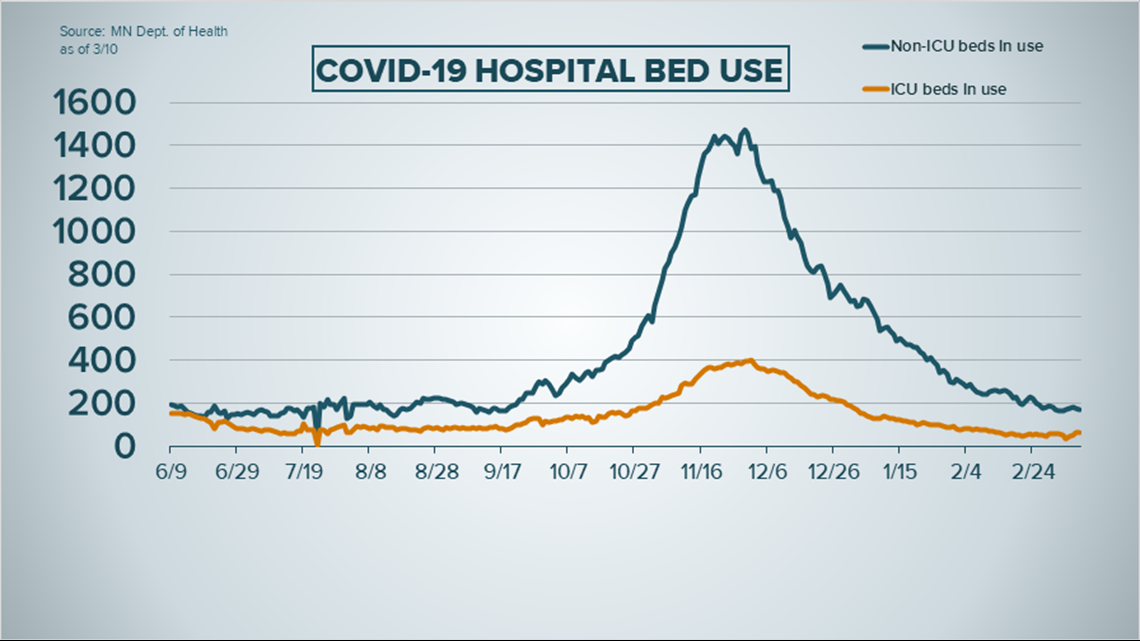
Those between the ages of 85 and 89 have suffered the most fatalities in the state with 1,275 deaths in 6,392 diagnosed cases. Young adults ages 20 to 24 still make up the largest group of cases with 48,923. Three people from that age group have died.
Minnesota's four most populous counties have reported the most COVID activity, with Hennepin County recording 102,498 cases and 1,626 deaths, Ramsey County 43,660 cases and 826 deaths, Dakota County 37,019 cases and 398 deaths, and Anoka County with 33,814 cases and 402 deaths.
Cook County in northeastern Minnesota remains quiet on the COVID front, reporting just 121 cases since the virus arrived in the state.

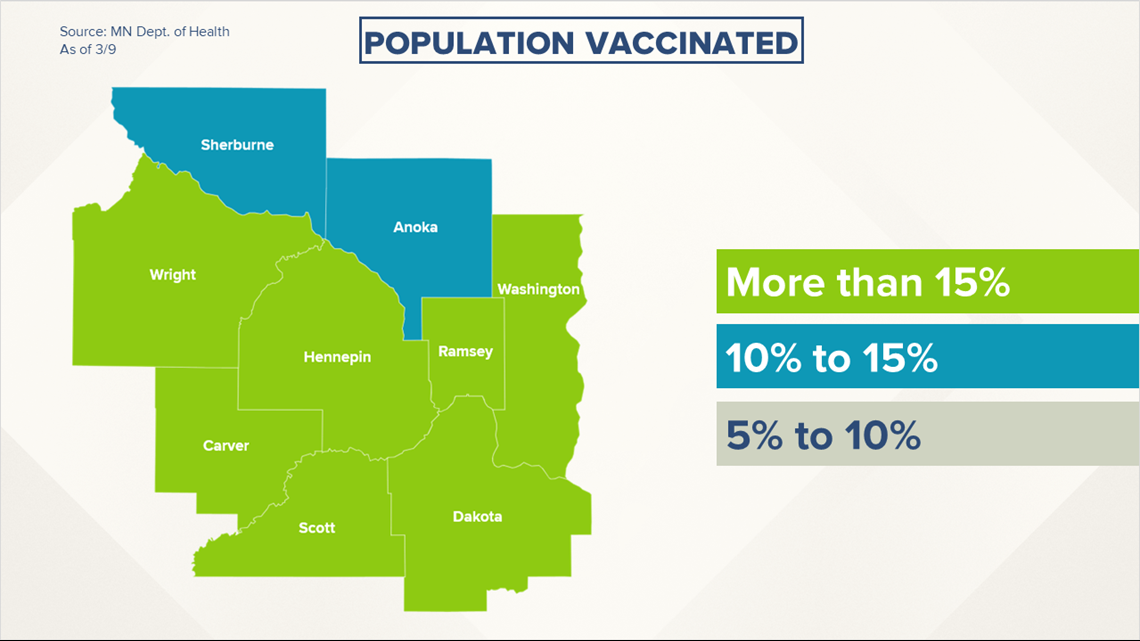
KARE 11’s coverage of the coronavirus is rooted in Facts, not Fear. Visit kare11.com/coronavirus for comprehensive coverage, and kare11.com/vaccine for answers to all of your questions about vaccines. Have a question? Text it to us at 763-797-7215. And get the latest coronavirus updates sent right to your inbox every morning. Subscribe to the KARE 11 Sunrise newsletter here. Help local families in need: www.kare11.com/give11.
The state of Minnesota has set up a data portal online at mn.gov/covid19.

